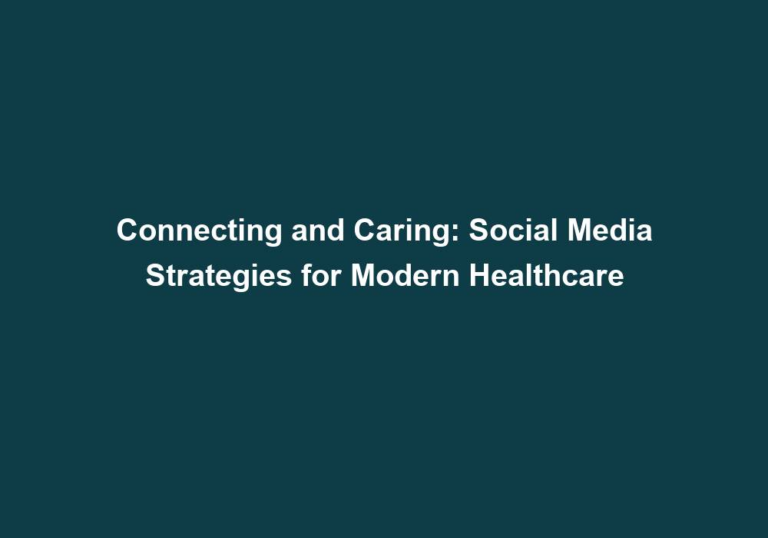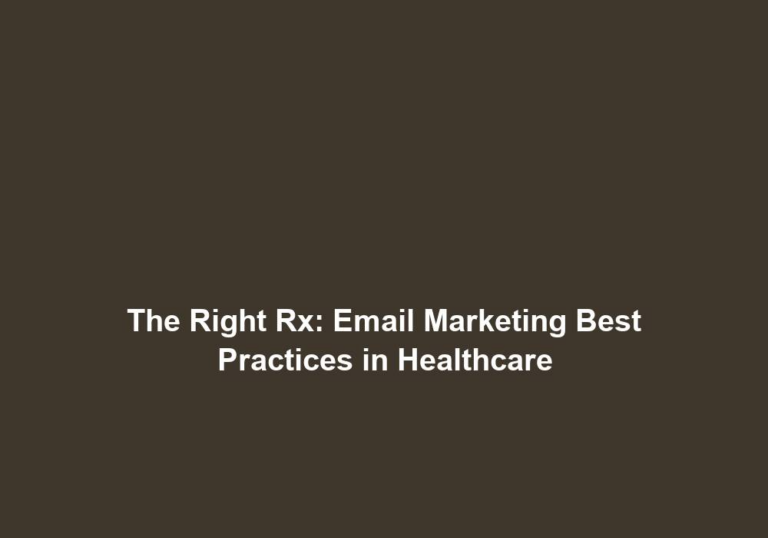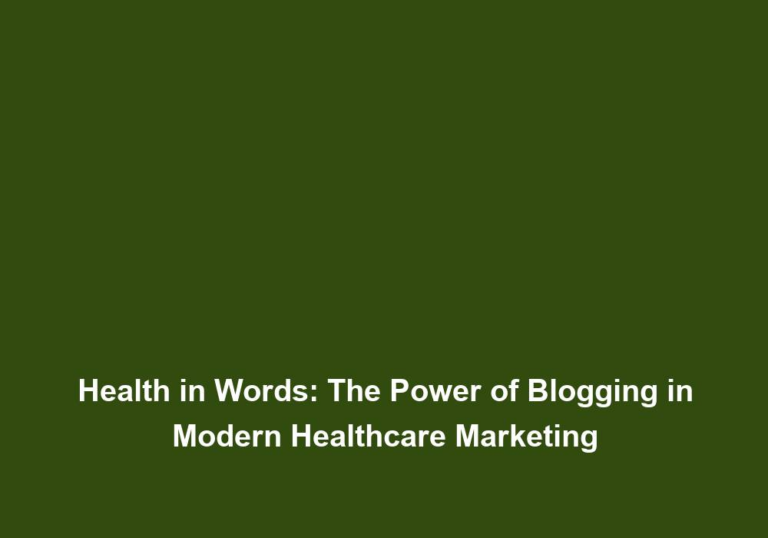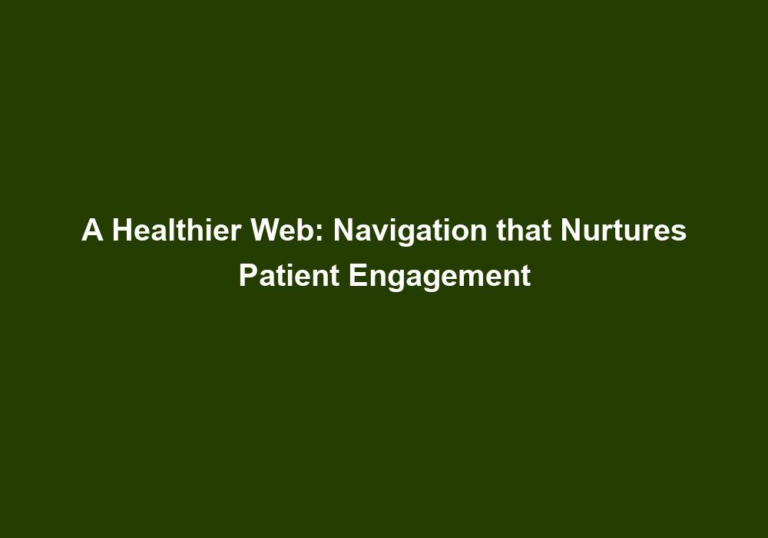Navigating Health: Enhancing Digital Patient Journeys through Content Marketing
In today’s digital age, the healthcare industry has witnessed a significant shift towards online platforms for information, communication, and even medical consultations. As patients increasingly turn to the internet to seek answers and support for their health concerns, healthcare providers must leverage content marketing strategies to enhance the digital patient journey. By providing valuable and reliable information, healthcare organizations can build trust, engage patients, and empower them to make informed decisions about their health.
The Importance of Content Marketing in Healthcare
Content marketing plays a crucial role in the healthcare industry by bridging the gap between patients and healthcare providers. It involves creating and distributing valuable, relevant, and consistent content to attract and retain a clearly-defined audience. When applied strategically, content marketing can significantly enhance the digital patient journey in several ways:
1. Educating Patients
By creating informative and educational content, healthcare providers can empower patients with knowledge about various health conditions, treatment options, preventive measures, and lifestyle choices. This not only helps patients make better decisions regarding their health but also reduces misinformation and encourages them to seek professional medical advice.
- Content can cover a wide range of topics, such as explaining different diseases and their symptoms, outlining available treatment options, and providing tips for maintaining a healthy lifestyle.
- By addressing common misconceptions and debunking health myths, healthcare organizations can ensure that patients have accurate information to make informed decisions about their well-being.
- Including real-life examples and case studies in the content can help patients relate to the information and understand its practical applications.
2. Building Trust and Credibility
In a digital landscape filled with unreliable sources, content marketing allows healthcare organizations to establish themselves as trustworthy and authoritative sources of information. By consistently delivering accurate and evidence-based content, healthcare providers can build credibility among patients, leading to increased trust in their services.
- Content should be backed by reputable sources, such as peer-reviewed research studies, medical journals, and expert opinions from healthcare professionals.
- Including references and citing sources within the content helps patients verify the information and perceive it as reliable.
- Testimonials and success stories from previous patients can also contribute to building trust and credibility, as they showcase the positive experiences others have had with the healthcare organization.
3. Improving Patient Engagement
Engaging patients throughout their healthcare journey is essential for better outcomes and increased patient satisfaction. Content marketing enables healthcare organizations to connect with patients on a deeper level by addressing their concerns, providing valuable tips, and offering personalized advice. Engaged patients are more likely to follow treatment plans, adhere to medication regimens, and actively participate in their own care.
- Interactive content, such as quizzes and assessments, can encourage patient engagement by allowing them to assess their knowledge or understand their risk factors for certain conditions.
- Including actionable tips and practical advice in the content can empower patients to take control of their health and make positive lifestyle changes.
- Creating forums or online communities where patients can interact with healthcare professionals and peers can foster engagement and provide a support system for individuals facing similar health challenges.
4. Enhancing Search Engine Visibility
Search engines have become the go-to resource for patients seeking health information. By implementing strong SEO (Search Engine Optimization) practices, healthcare organizations can ensure their content appears prominently in search engine results. This not only increases their visibility but also attracts more relevant traffic to their websites, ultimately leading to increased patient conversions.
- Conducting keyword research to identify the most commonly searched terms related to healthcare can help optimize content for search engines.
- Utilizing relevant headers and subheadings with targeted keywords can improve the chances of content being ranked higher in search engine results.
- Creating meta tags that accurately describe the content can entice users to click on the link and visit the healthcare organization’s website.
Best Practices for Content Marketing in Healthcare
To successfully navigate health and enhance digital patient journeys through content marketing, healthcare organizations must adhere to certain best practices:
1. Understanding the Target Audience
Before creating content, it is crucial to understand the target audience’s needs, preferences, and pain points. Conducting thorough market research and developing patient personas can help identify the most relevant topics and formats that resonate with the intended audience.
- Analyzing demographic data, such as age, gender, and location, can provide insights into the specific healthcare needs of the target audience.
- Considering the preferences of the target audience, such as their preferred content formats (articles, videos, infographics) and the platforms they use to consume information (websites, social media), can help tailor content to their preferences.
- Addressing common pain points and challenges faced by the target audience can create a sense of empathy and relevance, making the content more impactful.
2. Providing Accurate and Reliable Information
Healthcare content must be accurate, reliable, and evidence-based. It is essential to cite credible sources and ensure that the information provided aligns with current medical guidelines and research. Avoiding jargon and using plain language can make the content more accessible to a wider audience.
- Relying on reputable sources, such as medical associations, government health agencies, and academic institutions, can ensure the accuracy and reliability of the content.
- Including references and citations within the content allows patients to verify the information and understand the sources from which it is derived.
- Using clear and concise language, avoiding complex medical terminology, and providing explanations for technical terms can make the content more understandable and relatable to a broader audience.
3. Creating Engaging and Interactive Content
To capture and retain the attention of patients, healthcare organizations should focus on creating engaging and interactive content. This can include videos, infographics, quizzes, and interactive tools that encourage active participation and make the learning process enjoyable.
- Videos can be used to visually demonstrate medical procedures, explain complex concepts, and share patient testimonials.
- Infographics can present information in a visually appealing and easily digestible format, making it easier for patients to understand and remember.
- Quizzes and interactive tools can be designed to assess patients’ knowledge, provide personalized recommendations, or simulate real-life scenarios to enhance learning and engagement.
4. Optimizing Content for Search Engines
Implementing strong SEO practices is crucial for maximizing the visibility of healthcare content. Keyword research, proper meta tags, relevant headers, and optimizing for mobile devices are some essential aspects to consider when optimizing content for search engines.
- Conducting keyword research to identify relevant and high-traffic keywords can help optimize content for search engines.
- Incorporating keywords naturally within the content, including in headings, subheadings, and throughout the body, can improve search engine visibility.
- Ensuring that the content is mobile-friendly and loads quickly on mobile devices can enhance user experience and improve search engine rankings.
5. Leveraging Social Media Channels
Social media platforms provide an excellent opportunity to amplify the reach of healthcare content. By sharing valuable information, engaging with the audience, and encouraging user-generated content, healthcare organizations can establish a strong social media presence and foster a community of engaged patients.
- Sharing informative articles, videos, and infographics on social media platforms can attract a wider audience and drive traffic to the healthcare organization’s website.
- Engaging with followers by responding to comments, addressing their questions and concerns, and encouraging discussions can create a sense of community and build trust.
- Encouraging user-generated content, such as patient testimonials, success stories, and health challenges, can enhance patient engagement and foster a supportive online environment.
6. Promoting Collaboration and Partnerships
Collaborating with influencers, patient advocacy groups, and other healthcare stakeholders can significantly enhance the impact of content marketing efforts. By partnering with trusted individuals and organizations, healthcare providers can leverage their networks and expertise to reach a broader audience and build stronger relationships with patients.
- Collaborating with influential individuals in the healthcare industry, such as doctors, researchers, or patient advocates, can lend credibility and expand the reach of healthcare content.
- Partnering with patient advocacy groups or nonprofit organizations can help address specific health issues and raise awareness among the target audience.
- Engaging in cross-promotion with other healthcare providers or organizations can create a collaborative environment and provide patients with a comprehensive range of resources and services.
Conclusion
In an increasingly digital healthcare landscape, content marketing has emerged as a powerful tool to enhance the patient journey. By providing accurate information, building trust, promoting engagement, and leveraging search engine visibility, healthcare organizations can navigate health effectively and empower patients to make informed decisions about their well-being. By embracing best practices and adapting to evolving technologies, content marketing can revolutionize the way healthcare is delivered and experienced in the digital age.







